Your cart is currently empty!
How to Store Outdoor Area Rugs During Winter: Simple and Effective Tips

As the temperature drops and the leaves start to turn, many homeowners begin the task of winterizing their outdoor spaces. Part of this seasonal transition often involves taking care of outdoor area rugs, which have added comfort and style to patios and decks throughout the warmer months. Securing these rugs for winter is not only about cleaning; it’s about preserving their condition so they continue to enhance outdoor living areas year after year.
I understand the importance of preventing mold, mildew, and weather-related damage. From my experience, the key to storing outdoor area rugs during winter lies in the method of cleaning, drying, and rolling them up for storage. A proper offseason care routine ensures that they remain in good shape and ready to be rolled back out as soon as spring arrives.
Key Takeaways
- Cleaning and drying rugs before storage prevents mold and mildew.
- Rolling rugs for storage helps maintain their shape and appearance.
- Offseason care is essential for a rug’s longevity and readiness for spring.
Understanding Outdoor Rug Materials
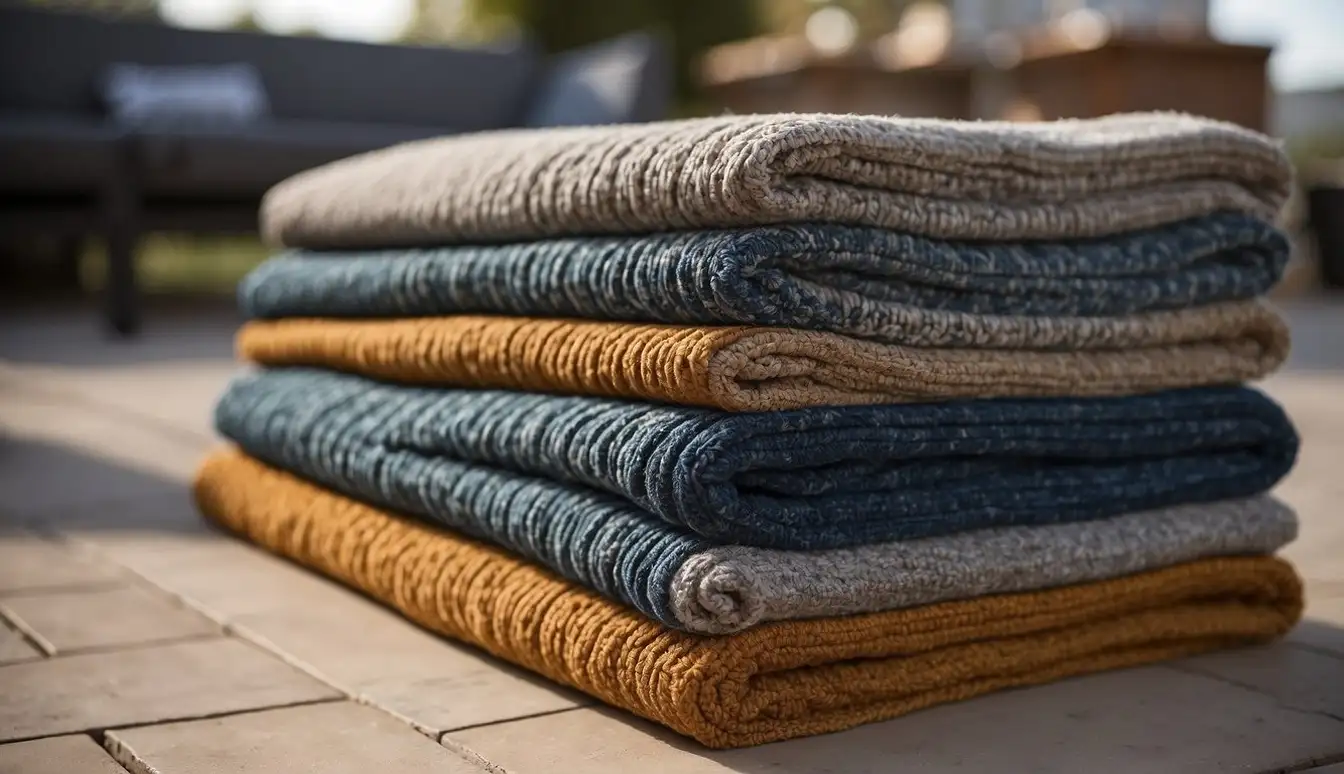
When I select outdoor rugs, I consider the fibers they’re made of because it influences their weather resistance and durability. Let’s explore the differences and the suitedness for winter.
Natural vs Synthetic Fibers
Natural fibers, such as jute, sisal, and cotton, offer an eco-friendly option with an authentic texture. However, it’s important to remember that these materials are less tolerant to moisture and cold weather. Synthetic fibers like polypropylene and nylon are engineered for durability. They are also mold and fade-resistant, making them better suited for varying weather conditions.
Weather Resistance and Durability
Outdoor rugs made from synthetic fibers, specifically polypropylene, stand out in terms of weather resistance. This material is particularly reliable in withstanding rain, snow, and UV rays without fraying or fading. Moreover, synthetic rugs maintain their integrity during freezing and thawing cycles, ensuring durability throughout the winter season. Natural fibers, while charming, may not fare as well under constant exposure to harsh winter elements.
Pre-Winter Cleaning and Maintenance
Before tucking your outdoor area rugs away for winter, it’s crucial to give them a thorough clean. This ensures they remain in good shape for when the warmer weather returns. Let’s break it down into simple steps.
Removing Dirt and Debris
The first thing I do is shake out the rug to dislodge any loose dirt. Then, I go over it with a vacuum to get rid of anything that’s left. It’s vital to use a brushless suction head on the vacuum to prevent damaging the rug’s fibers.
Addressing Mold and Mildew
If I spot any mold or mildew, I create a solution of water and mild detergent to treat the affected areas. I carefully scrub the spots with a soft brush and rinse thoroughly with a hose. Avoid using bleach as it can harm the rug’s color and material.
Drying Before Storage
After washing, it’s essential to let the rug dry completely to prevent moisture from becoming trapped and causing damage during storage. I lay mine flat and flip it over periodically to ensure all sides dry evenly. It’s best to do this on a sunny, breezy day to utilize natural drying power.
Proper Storage Techniques
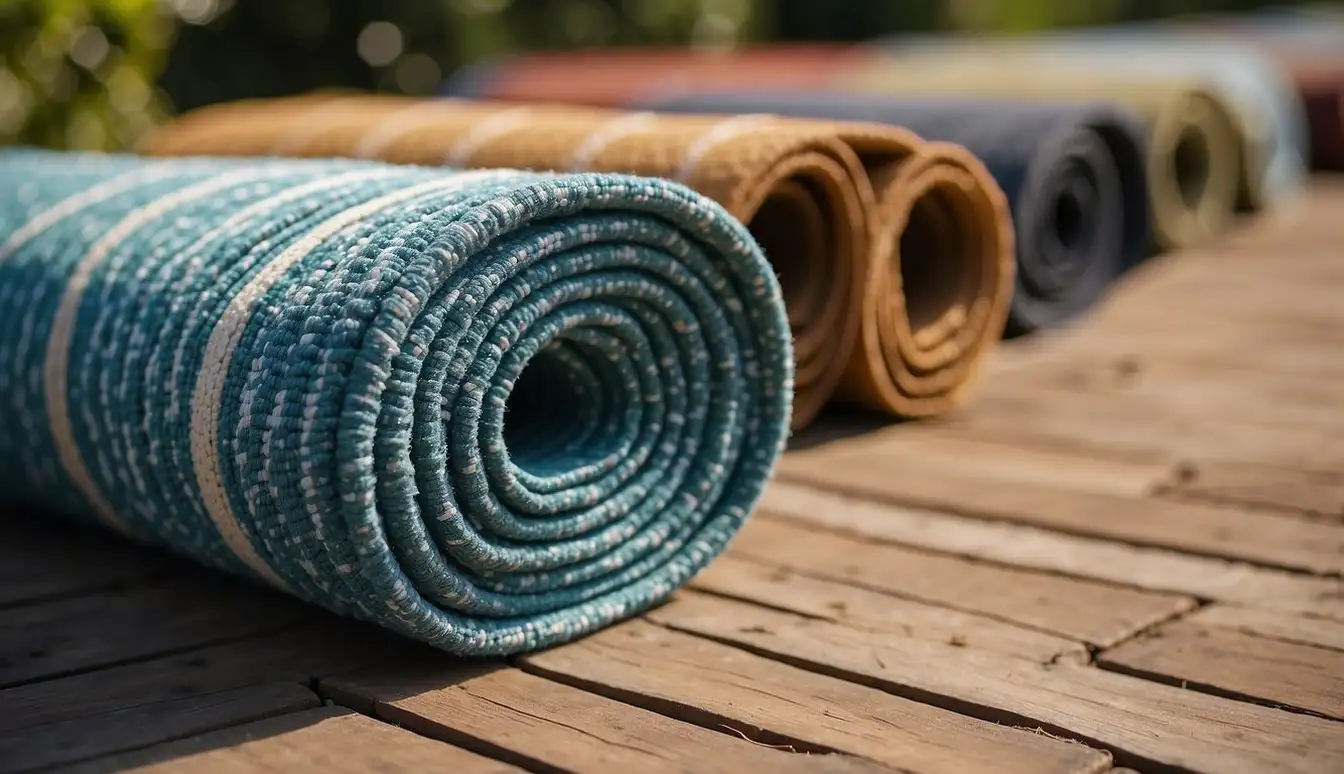
When it comes to preserving outdoor area rugs during the winter, I find that proper rolling, selecting an optimal storage location, and safeguarding against pests and damage are crucial steps.
Rolling vs Folding Outdoor Rugs
When I store my outdoor rugs, I always opt to roll rather than fold them. Rolling prevents creases and preserves the rug’s structure. I start by laying the rug flat on the ground and rolling it tightly, starting from one end. To keep the rug straight, it helps to use a curtain rod or wooden dowel at the beginning of the roll. For delicate rugs, a cotton or muslin sheet wrapped around the roll offers an additional layer of protection.
Choosing the Right Storage Location
Finding a dry, cool place such as a basement, garage, or attic is essential for storage. However, I pay special attention to ensure the chosen area is free from moisture and not prone to temperature swings, which might damage the rug. It should also allow the rug to breathe, preventing mold and mildew growth. I avoid placing the rug directly on concrete or against bare walls to minimize moisture absorption.
Protecting Rugs from Pests and Damage
To safeguard my rugs from insects, pests like mice, or any other potential damage, I use a few tactics. Before storage, I make sure the rug is clean and completely dry. Then, I either wrap the rug in a breathable material like canvas or place it in a specialized storage bag that guards against moisture and pests but still allows air circulation. I stay clear of plastic wraps that trap moisture. Lastly, I check the storage area periodically for signs of pests or damage.
Routine Care During Off-Season
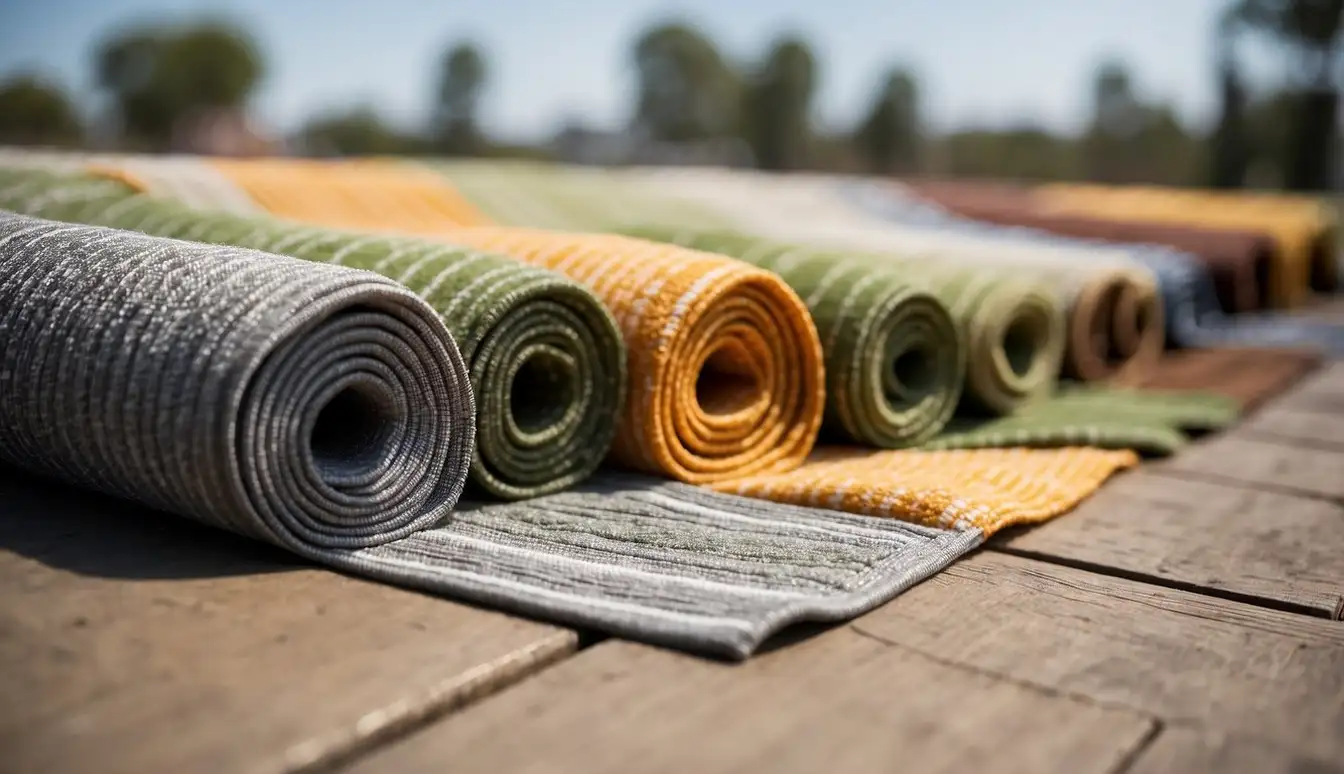
When I store my outdoor rugs during the winter, I make sure to give them the attention they need to stay in top condition. This includes regular checks and ensuring they are stored in an environment with adequate ventilation and temperature control.
Regular Inspection
I always take time every few weeks to inspect my stored rugs for any signs of damage or moisture. I unroll them carefully and check both sides, keeping an eye out for mildew or pests. If I find moisture, I’ll clean the area and dry my rug thoroughly before rolling it back up.
Adequate Ventilation and Temperature Control
To prevent any damage from humidity, I make sure my storage area is moisture-resistant and well-ventilated. Rugs need to breathe, so it’s important to store them in a cool, dry place. Maintaining a consistent, cool temperature is essential to avoid the harshness of winter weather affecting the rugs. If I don’t have an ideal indoor space, I consider climate-controlled storage options as an investment in maintaining my rugs’ condition.
Preparing for Next Season
As spring approaches and I look forward to enjoying my outdoor space again, it’s crucial to take the right steps to ensure my outdoor area rug is ready. Here’s how I prepare my rug for a new season of enjoyment on my deck, patio, or porch.
Assessing Rug Condition
Before I reintroduce my rug to the outdoor elements, I always check its condition. It’s important for the longevity of the rug to catch any issues early. Here’s what I look for:
- Wear and Tear: Any signs of fraying or damage that might need repairing.
- Mold or Mildew: Especially if the storage area had any dampness.
- Color Fade: Prolonged exposure before storage might have caused some fading.
If the rug is severely damaged, I consider whether it is worth repairing or if it might be time for a replacement.
Post-Winter Cleaning
Even if I stored my rug properly during the winter, I make sure to clean it before putting it back out. This freshens it up and ensures it’s ready for use. Here’s what I do:
- Shake: I’ll give it a good shake to remove any loose debris.
- Vacuum: To get rid of any lingering dirt.
- Spot Clean: Any stains are treated with a mixture of mild detergent and water.
- Air Dry: The rug must be completely dry before I lay it back down, to avoid any mold.
It’s also key for me to clean the surface beneath the rug, which includes sweeping the deck or patio and ensuring any rug pads are also free of dirt and ready for use.
Reinstallation and Use
Once the rug is clean and the outdoor area prepared, it’s time to roll out the rug for the season—literally.
- Align and Roll Out: I align it correctly on the designated area and roll it out smooth.
- Secure Edges: If needed, I use double-sided rug tape or weighted corners to prevent the edges from curling up.
- Furniture Placement: I place furniture strategically, both to enhance the aesthetic appeal and to help anchor the rug in place.
By carefully assessing the condition, cleaning, and correctly reinstalling my outdoor area rug, I extend its life and maximize my enjoyment in my outdoor living space. Spring and summer on my patio, deck, or porch are now ready to be enjoyed to the fullest.
Tips for Extending Rug Lifespan
Taking care of your outdoor area rugs is essential to extend their lifespan. I suggest specific measures to protect your rugs from weather-related damage, especially during winter months when they are most vulnerable.
Avoiding Direct Sunlight and Harsh Elements
Direct sunlight can fade rugs quickly, so I recommend placing them in areas with partial shade to minimize exposure. When I choose a location for my rug, I avoid placing it under direct sunlight for prolonged periods, which helps maintain the vibrant colors and integrity of the material. For those times when harsh weather is anticipated, such as heavy rain or snow, I either move my durable outdoor rugs to a sheltered area or cover them with a weatherproof cover to protect against the elements.
Dealing with Snow and Ice Exposure
I always ensure to remove snow and ice from my outdoor rugs promptly. Letting snow or ice sit on the rug can lead to moisture damage and a reduced lifespan. If I find snow on my rug, I use a broom or a hand brush to sweep it off gently. For ice, I avoid using sharp tools; instead, I sprinkle a little bit of salt to help melt the ice, then blot the excess moisture with a towel. Regular removal of snow and ice, combined with proper storage during heavy winter conditions, helps preserves the rug’s structure and appearance, ensuring it can handle foot traffic when the weather improves.
Choosing Rugs for Different Climates
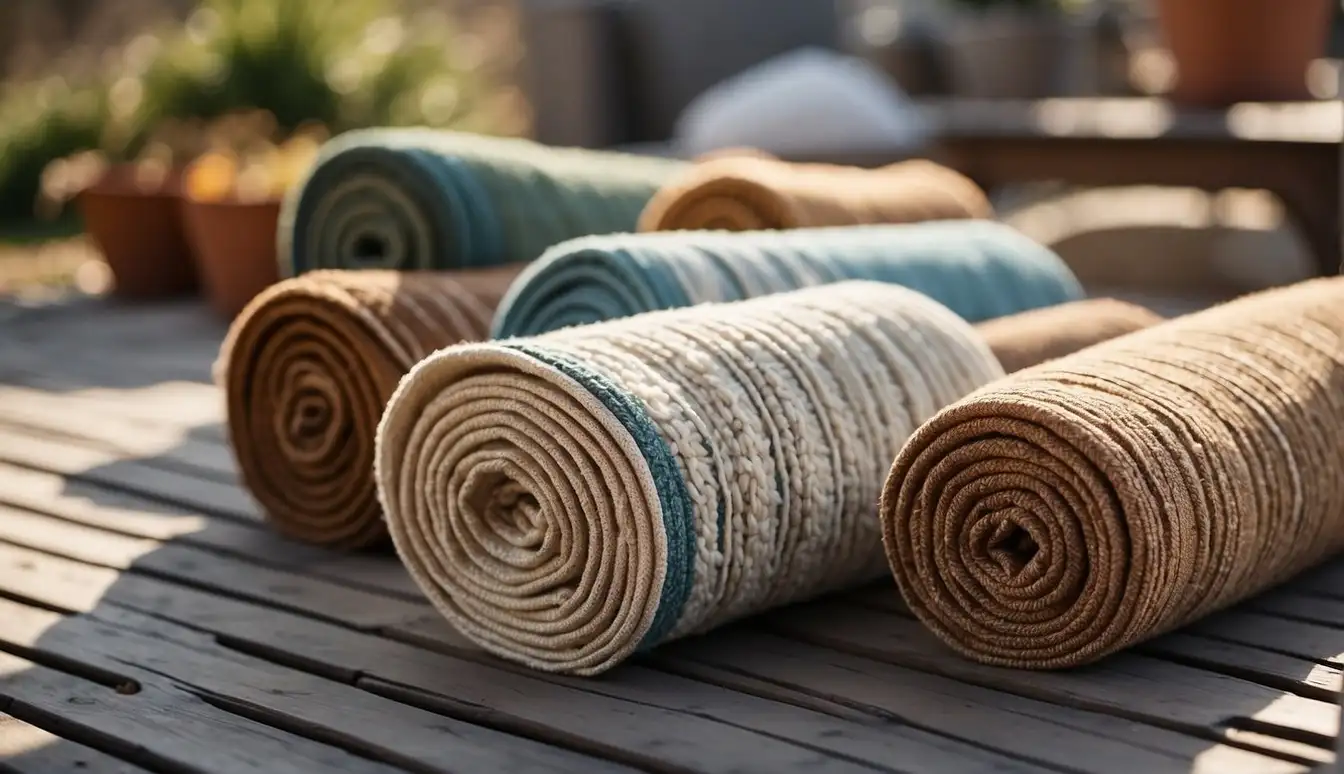
When selecting outdoor area rugs, it’s vital to consider the local climate. I’ll guide you through the best choices for warmer regions and colder climates, focusing on materials and features that cater to each environment’s specific needs.
Rugs for Warmer Regions
In warmer regions like Florida, outdoor rugs face high humidity and intense sun exposure. For these areas, I recommend looking for rugs that are water-resistant and can withstand UV rays to prevent fading. Here are my top picks for these climates:
- Polypropylene Rugs: They are not only water-resistant but also resist mold and mildew, making them perfect for Florida’s humidity.
- Nylon Rugs: These are tough and resist wear and tear, ideal for high-traffic areas.
Always opt for light-colored rugs as they reflect sunlight and stay cooler to the touch.
Rugs for Colder Climates
In places like Minnesota, where winters are harsh, outdoor rugs must be winter-proof and moisture-resistant. Here’s what I’d go for:
- Polyester Rugs: They offer good moisture resistance and can survive snowy conditions, keeping your space dry and clean.
- Acrylic Rugs: These are often recommended for colder climates due to their moisture-resistant properties and ability to retain color and warmth.
It’s crucial to choose a rug that can be easily rolled up and stored away during the harshest winter months to prevent damage from ice and snow.
Frequently Asked Questions
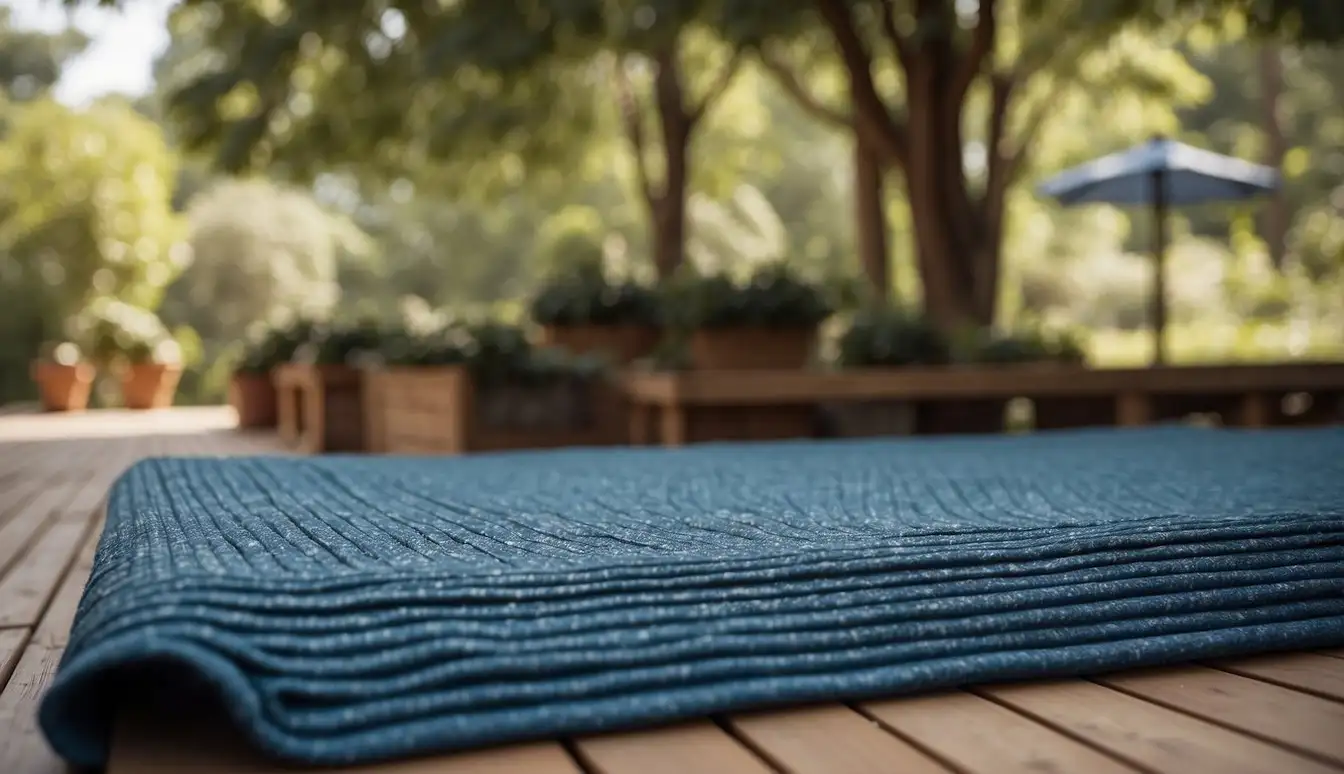
Proper winter storage of outdoor area rugs is important to maintain their quality and longevity. I’ve gathered some of the common questions and provided straightforward answers below to help you protect your rugs during the cold season.
What is the best way to protect outdoor area rugs from snow and ice?
To protect outdoor area rugs from snow and ice, I recommend cleaning them thoroughly and storing them in a dry place. Rolling the rug and wrapping it in a waterproof cover such as polyurethane wrap or heavy-duty tarp could prevent moisture damage and make them last longer through the winter.
Are there special considerations for storing polypropylene rugs in cold weather?
Polypropylene rugs are durable and moisture-resistant, but it’s still best to store them away from cold weather. Ensuring they are dry before rolling and covering them with breathable fabric can prevent moisture buildup and damage during storage.
Can outdoor rug pads help extend the life of area rugs over the winter months?
Yes, using outdoor rug pads can provide an extra layer of cushioning and protection for area rugs, which may help extend their life. Rug pads prevent abrasion against rough surfaces and may keep the rug from retaining moisture, which is especially beneficial over the winter months.
How do you prevent mold and mildew on rugs that are stored during the winter?
To prevent mold and mildew, I store rugs in a well-ventilated area after making sure they are completely dry. Using desiccants like silica gel packets in storage can also help absorb any residual moisture.
What are the risks of using indoor rugs in outdoor spaces during winter?
Using indoor rugs outside can expose them to moisture, leading to damage and mold accumulation. Indoor rugs are not made to withstand harsh weather, so their fibers can break down more quickly when used outdoors during winter.
Is it necessary to use a rug storage bag when keeping area rugs outside in winter?
Using a rug storage bag when keeping area rugs outside in winter is crucial. The bag protects the rug from snow, rain, and pests. It’s best to choose storage bags without ventilation holes to offer better protection against the elements.
